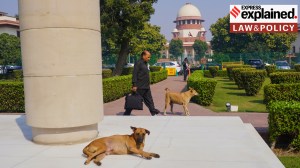Still the untouchable
It was on this day 75 years ago that the Kerala unit of the Indian National Congress initiated a satyagraha demanding the universal right...

It was on this day 75 years ago that the Kerala unit of the Indian National Congress initiated a satyagraha demanding the universal right to movement on the road leading to the famed Sri Mahadevar temple at Vaikom in Kerala. The satyagraha was the culmination of a series of protest movements initiated by the Untouchables against the iniquitous social order that existed in the state forcing Swami Vivekananda, on one occasion, to call Kerala a lunatic asylum.
It was not all of a sudden that the Congress chose to take up the social cause that the Vaikom satyagraha represented. In fact, the movements for equality launched by such pioneering social and religious reformers as Sri Narayana Guru, Ayyankali and Mannath Padmanabha Pillai provided an ideal backdrop for the satyagraha. It is an irony that while Congress president Sonia Gandhi is keen to participate in the Platinum Jubilee of the satyagraha and thereby hog the limelight, the national leadership of the party was at that time in two minds on lending itsname and strength to the agitation which was more social than religious.
In fact, Mahatma Gandhi endorsed the agitation only after Sri Narayana Guru, who preached the revolutionary concept of "one caste, one religion and one God", Shradhananda from Punjab, who made interdining with Dalits a tool to fight untouchability and the atheist, E.V. Ramaswamy Naicker, who converted the anti-Brahmin feeling in his region into a powerful political and social movement, explicitly urged him to do so. Even when Gandhi plunged into the agitation and Vaikom captured the headlines in the national Press, there was no certainty that the agitation would bear fruit.
This is because obscurantist forces were so well-entrenched in society that any attempt to weaken their hold was certain to be resisted with all their might. Small wonder that the agitation continued for about one year.
The resistance should be seen against the fact that until the mid-twentieth century, Kerala society was one of the most rigidly stratified inthe whole country. It was common for Untouchables to ring a bell to announce their polluting presence and to wear spittoons so that no polluting spittle could drop from their lips and spread contagion. It was a society where the women of low castes were prevented from covering their breasts and had to launch a relentless and, at times, violent struggle to obtain the right to cover their upper torso.
Of course, untouchability did not provide the women protection from sexual abuse. The Nadar Christians were the first to demand the right to wear blouses, which their counterparts in other low castes too raised in due course. The upper castes did not remain mute spectators; there were instances after instances when women were forcibly stripped of their blouses in the bazars of Travancore. Traditionally, they were expected to wear only bead necklaces to cover their breasts.
It was in this milieu that Ayyankali, an illiterate Pulaya leader, began organising the docile Pulaya community. It is a truism that thefirst agricultural labour strike in Kerala that he organised was not to demand more wages but for the rights of the Pulayas to send their children to schools. While these agitations had an impact and the Untouchables got the right to movement on public roads, they still did not enjoy right to access to temples and the roads that led to them. In protest, some Pulayas led by Kurumban stormed the Chengannur temple in 1917. But the orthodoxy stood firm.
The arrival of Gandhi in 1925 metamorphosed the Vaikom agitation and before long the road was declared "open to non-Hindus". Gandhi always believed untouchability was a historical corruption of Hinduism which could be corrected by right-minded caste Hindus unlike Ambedkar, who saw Hinduism as irredeemable, as having an essential and not merely a historical association with dehumanising discrimination. This explains his eventual search for a new identity that brought a large number of the Mahars into the Buddhist fold.
At the end of the Vaikom satyagarha, allthat the Untouchables got was the right to walk on that small strip of road. In order to enter the temple they had to wait until 1936 when the Temple Entry Proclamation was made by the Travancore maharajah. The proclamation was a precursor of the Madras Act of 1938, making open all secular institutions like roads, wells, transport and restaurants to Untouchables.
Nonetheless, in Kerala as indeed in other states, entry to temples like Guruvayoor was restricted until India opted for a Republican form of government. It was then presumed that all public places were open to citizens irrespective of their caste and there would no longer be any caste-based discrimination. But how farfetched that hope was! Even 50 years after Independence and even after the President of the country happens to be from the Dalit community, there are vast areas where Untouchables are barred from entering village temples and barbers refuse to serve them.
According to recent media reports, they are served in separate plates andglasses which they later have to wash in hotels and restaurants at Anantapur in Andhra Pradesh — which has, incidentally, also produced a President of India — and at Bellary in Karnataka. What’s worse, even in the national Capital, scheduled caste students of a medical college are segregated in the college hostel. The modern-day scheduled caste medical student’s predicament is only slightly better than that of Ambedkar, who had to go from pillar to post to get an accommodation as a student in Baroda. The reports bear out the fact that the mind-boggling findings of I.P. Desai’s surveys, conducted in the rural areas some 30 years ago, are still valid.
It is this discrimination, covert in the cities and overt in the villages, which is at the root of the stirrings among the lower castes, who after 50 years of Independence realise that reservation in jobs and legislatures has not brought them the desired social status. And they feel worried when an innocuous concern the President expresses on theunder-representation for the Dalit communities in the upper reaches of the judiciary is seen by powerful sections as an abominable aberration.
Even religions which promised them equality find it convenient to ask for reservation rather than end discriminations within their own ranks. If in the wake of the killings in Jehanabad the Dalits feel they have become pawns on the political chessboard, it cannot be helped. They know how in the past a Dalit’s audacity in giving his daughter the same name as that of the local landlord’s granddaughter had evoked a violent reaction from the upper castes. For them things have not changed much since Jataka told the tale of a famished young Brahmin who shared the food of an Untouchable, and then went on to die in despair in the forest.



- 01
- 02
- 03
- 04
- 05




























